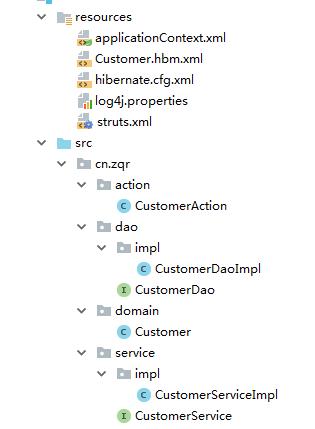SSH整合方案一(带有hibernate.cfg.xml)
Posted 必须往前走
tags:
篇首语:本文由小常识网(cha138.com)小编为大家整理,主要介绍了SSH整合方案一(带有hibernate.cfg.xml)相关的知识,希望对你有一定的参考价值。
整体结构

1.导入响应的jar包
2.在web.xml中配置struts的过滤器和spring整合web的监听器

<!--配置Spring整合web的监听器--> <listener> <listener-class>org.springframework.web.context.ContextLoaderListener</listener-class> </listener> <context-param> <param-name>contextConfigLocation</param-name> <param-value>classpath:applicationContext.xml</param-value> </context-param> <!--配置struts的过滤器--> <filter> <filter-name>struts</filter-name> <filter-class>org.apache.struts2.dispatcher.ng.filter.StrutsPrepareAndExecuteFilter</filter-class> </filter> <filter-mapping> <filter-name>struts</filter-name> <url-pattern>/*</url-pattern> </filter-mapping>
3.编写Action,使用继承ActionSupport的方式创建Action,并使用模型驱动来封装表单
在Action中编写需要调用的Service层的属性,并提供set方法

public class CustomerAction extends ActionSupport implements ModelDriven{ private CustomerService customerService; public void setCustomerService(CustomerService customerService) { this.customerService = customerService; } //必须手动new private Customer customer=new Customer(); //模型和属性驱动 /** * 保存客户 * @return */ public String add(){ customerService.save(customer); return NONE; } @Override public Object getModel() { return customer; } }
4.编写struts的配置文件,struts.xml中我们主要配置Action,将Action的创建由Spring来管理,在struts.xml主要对bean的引用
(1)将Action的创建由Spring管理

<!--配置Action必须多例--> <bean id="customerAction" class="cn.zqr.action.CustomerAction" scope="prototype"> <property name="customerService" ref="customerService"/> </bean>
(2)在struts.xml主要对bean的引用

<package name="crm" namespace="/" extends="struts-default"> <!--Action由Spring管理,class值为Spring的id--> <action name="customer_*" class="customerAction" method="{1}"> </action> </package>
5.编写service层,service中主要需要对dao层的调用,和开启事务两步
对dao层的调用,采用Spring对bean的管理方法,在类中提供dao层的对象,并提供对应的set方法

@Transactional
public class CustomerServiceImpl implements CustomerService {
private CustomerDao customerDao;
public void setCustomerDao(CustomerDao customerDao) {
this.customerDao = customerDao;
}
/**
* 保存客户信息
* @param customer
*/
@Override
public void save(Customer customer) {
customerDao.add(customer);
}
}

<!--配置service--> <bean id="customerService" class="cn.zqr.service.impl.CustomerServiceImpl"> <property name="customerDao" ref="customerDao"/> </bean> <!--配置sessionFacotry--> <bean class="org.springframework.orm.hibernate5.LocalSessionFactoryBean" id="sessionFactory"> <property name="configLocation" value="classpath:hibernate.cfg.xml"/> </bean> <!--配置事务--> <bean class="org.springframework.orm.hibernate5.HibernateTransactionManager" id="transactionManager"> <property name="sessionFactory" ref="sessionFactory"/> </bean> <!--开始事务的注解--> <tx:annotation-driven/>
事务的管理和dao层的持久化都依赖于session,使用Spring管理sessionFactory的创建,并开始事务注解
6.编写dao层,dao层采用继承HibernateDaoSupport类的方式实现,需要使用HibernateDaoSupport类中的方法获取jdbc模板
dao层代码

public class CustomerDaoImpl extends HibernateDaoSupport implements CustomerDao {
/**
* 保存客户
*/
@Override
public void add(Customer customer) {
System.out.println("持久层Customer customer"+customer);
this.getHibernateTemplate().save(customer);
}
}
dao层的配置

<!--配置dao--> <bean id="customerDao" class="cn.zqr.dao.impl.CustomerDaoImpl"> <property name="sessionFactory" ref="sessionFactory"/> </bean>
编写实体类和配置hibernate配置文件不做详解,代码如下:

<?xml version="1.0" encoding="UTF-8"?> <!DOCTYPE hibernate-configuration PUBLIC "-//Hibernate/Hibernate Configuration DTD 3.0//EN" "http://www.hibernate.org/dtd/hibernate-configuration-3.0.dtd"> <hibernate-configuration> <session-factory> <!-- 必须配置 --> <property name="hibernate.connection.driver_class">com.mysql.jdbc.Driver</property> <property name="hibernate.connection.url">jdbc:mysql:///ssh</property> <property name="hibernate.connection.username">root</property> <property name="hibernate.connection.password">admin</property> <property name="hibernate.dialect">org.hibernate.dialect.MySQLDialect</property> <!-- 可选配置 --> <property name="hibernate.show_sql">true</property> <property name="hibernate.format_sql">true</property> <property name="hibernate.hbm2ddl.auto">update</property> <!-- 配置C3P0的连接池 --> <property name="connection.provider_class">org.hibernate.c3p0.internal.C3P0ConnectionProvider</property> <!-- 映射配置文件 --> <mapping resource="Customer.hbm.xml"></mapping> </session-factory> </hibernate-configuration>

<?xml version="1.0" encoding="UTF-8"?> <!DOCTYPE hibernate-mapping PUBLIC "-//Hibernate/Hibernate Mapping DTD 3.0//EN" "http://www.hibernate.org/dtd/hibernate-mapping-3.0.dtd"> <hibernate-mapping> <class name="cn.zqr.domain.Customer" table="cst_customer"> <id name="cust_id" column="cust_id"> <generator class="native"/> </id> <property name="cust_name" column="cust_name"/> <property name="cust_user_id" column="cust_user_id"/> <property name="cust_create_id" column="cust_create_id"/> <property name="cust_source" column="cust_source"/> <property name="cust_industry" column="cust_industry"/> <property name="cust_level" column="cust_level"/> <property name="cust_linkman" column="cust_linkman"/> <property name="cust_phone" column="cust_phone"/> <property name="cust_mobile" column="cust_mobile"/> </class> </hibernate-mapping>

package cn.zqr.domain;
public class Customer {
private Long cust_id;
private String cust_name;
private Long cust_user_id;
private Long cust_create_id;
private String cust_source;
private String cust_industry;
private String cust_level;
private String cust_linkman;
private String cust_phone;
private String cust_mobile;
public Long getCust_id() {
return cust_id;
}
public void setCust_id(Long cust_id) {
this.cust_id = cust_id;
}
public String getCust_name() {
return cust_name;
}
public void setCust_name(String cust_name) {
this.cust_name = cust_name;
}
public Long getCust_user_id() {
return cust_user_id;
}
public void setCust_user_id(Long cust_user_id) {
this.cust_user_id = cust_user_id;
}
public Long getCust_create_id() {
return cust_create_id;
}
public void setCust_create_id(Long cust_create_id) {
this.cust_create_id = cust_create_id;
}
public String getCust_source() {
return cust_source;
}
public void setCust_source(String cust_source) {
this.cust_source = cust_source;
}
public String getCust_industry() {
return cust_industry;
}
public void setCust_industry(String cust_industry) {
this.cust_industry = cust_industry;
}
public String getCust_level() {
return cust_level;
}
public void setCust_level(String cust_level) {
this.cust_level = cust_level;
}
public String getCust_linkman() {
return cust_linkman;
}
public void setCust_linkman(String cust_linkman) {
this.cust_linkman = cust_linkman;
}
public String getCust_phone() {
return cust_phone;
}
public void setCust_phone(String cust_phone) {
this.cust_phone = cust_phone;
}
public String getCust_mobile() {
return cust_mobile;
}
public void setCust_mobile(String cust_mobile) {
this.cust_mobile = cust_mobile;
}
@Override
public String toString() {
return "Customer [cust_id=" + cust_id + ", cust_name=" + cust_name + ", cust_user_id=" + cust_user_id
+ ", cust_create_id=" + cust_create_id + ", cust_source=" + cust_source + ", cust_industry="
+ cust_industry + ", cust_level=" + cust_level + ", cust_linkman=" + cust_linkman + ", cust_phone="
+ cust_phone + ", cust_mobile=" + cust_mobile + "]";
}
}
以上是关于SSH整合方案一(带有hibernate.cfg.xml)的主要内容,如果未能解决你的问题,请参考以下文章
